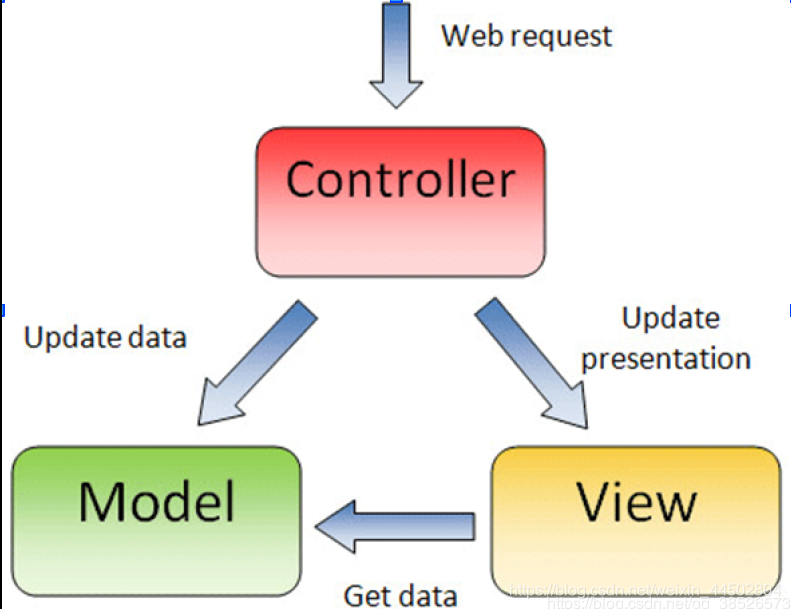一、 SpringMVC
1.MVC介绍
模式-视图-控制器
MVC是一个众所周知的以设计界面应用程序为基础的设计模式。它主要通过分离模型、视图以及控制器在应用程序中的角色将业务逻辑从界面中解耦。通常,模型负责封装应用程序数据在视图层展示。视图仅仅只是展示这些数据,不包含任何业务逻辑。控制器负责接收来自用户的请求,并调用后台服务(manager或者dao)来处理业务逻辑。处理后,后台业务层可能会返回了一些数据在视图层展示。控制器收集这些数据及准备模型在视图层展示。 MVC模式的核心思想是将业务逻辑从界面中分离出来,允许它们单独改变而不会相互影响。

2.SpringMVC介绍
介绍:
1.Spring Web MVC 是一种基于Java实现了Web MVC设计模式的请求驱动类型的轻量级Web框架
2.使用了MVC架构模式的思想,将Web层职责解耦
3.基于请求驱动指的就是使用请求响应请求-响应模型
4.框架的目的就是帮助我们简化开发
Spring Web MVC也是要简化我们日常Web开发的
优点
1.性能比struts2好
2.简单、便捷、易学
3.和spring无缝衔接【IOC,AOP】
4.使用约定优于配置
5.支持Restful
6.异常处理,国际化,数据验证,类型转换等
7.使用的人多,使用的公司多
第一种方式:配置文件的方式:
1.创建项目 导入需要的jar包:

2.创建配置文件 设置处理器与映射器
<?xml version="1.0" encoding="UTF-8"?>
<beans xmlns="http://www.springframework.org/schema/beans"
xmlns:xsi="http://www.w3.org/2001/XMLSchema-instance"
xsi:schemaLocation="http://www.springframework.org/schema/beans
http://www.springframework.org/schema/beans/spring-beans.xsd">
<!-- 指定处理器映射器 -->
<bean class="org.springframework.web.servlet.handler.BeanNameUrlHandlerMapping"></bean>
<!-- 指定处理器适配器 -->
<bean class="org.springframework.web.servlet.mvc.SimpleControllerHandlerAdapter"></bean>
<!-- 注册自定义的控制器 -->
<bean class="com.sxt.controller.HelloController" name="/hello"/>
</beans>
3.配置前端控制器
<?xml version="1.0" encoding="UTF-8"?>
<web-app xmlns:xsi="http://www.w3.org/2001/XMLSchema-instance" xmlns="http://java.sun.com/xml/ns/javaee" xsi:schemaLocation="http://java.sun.com/xml/ns/javaee http://java.sun.com/xml/ns/javaee/web-app_3_0.xsd" id="WebApp_ID" version="3.0">
<display-name>SpringMVC-01-Hello</display-name>
<welcome-file-list>
<welcome-file>index.html</welcome-file>
<welcome-file>index.htm</welcome-file>
<welcome-file>index.jsp</welcome-file>
<welcome-file>default.html</welcome-file>
<welcome-file>default.htm</welcome-file>
<welcome-file>default.jsp</welcome-file>
</welcome-file-list>
<!-- 配置SpringMVC的前端控制器 中央控制器 -->
<servlet>
<servlet-name>SpringMVC</servlet-name>
<servlet-class>org.springframework.web.servlet.DispatcherServlet</servlet-class>
<init-param>
<param-name>contextConfigLocation</param-name>
<param-value>classpath:springmvc.xml</param-value>
</init-param>
<load-on-startup>2</load-on-startup>
</servlet>
<!-- 配置SpringMVC的映射地址 -->
<servlet-mapping>
<servlet-name>SpringMVC</servlet-name>
<url-pattern>/</url-pattern>
</servlet-mapping>
</web-app>
4.创建自定义的Controller
package com.sxt.controller;
import javax.servlet.http.HttpServletRequest;
import javax.servlet.http.HttpServletResponse;
import org.springframework.web.servlet.ModelAndView;
import org.springframework.web.servlet.mvc.Controller;
/**
* 自定义的控制器
* 具体处理用户请求的
* @author IF
*
*/
public class HelloController implements Controller{
@Override
public ModelAndView handleRequest(HttpServletRequest arg0, HttpServletResponse arg1) throws Exception {
System.out.println("--执行了--");
ModelAndView mav=new ModelAndView();
mav.setViewName("/index.jsp");
return mav;
}
}
5.jsp页面
<%@ page language="java" contentType="text/html; charset=utf-8"
pageEncoding="utf-8"%>
<!DOCTYPE html PUBLIC "-//W3C//DTD HTML 4.01 Transitional//EN" "http://www.w3.org/TR/html4/loose.dtd">
<html>
<head>
<meta http-equiv="Content-Type" content="text/html; charset=utf-8">
<title>Insert title here</title>
</head>
<body>
<h1>HELLO SpringMVC</h1>
</body>
</html>
6.实现

第二种实现方式:注解的方式
只有控制层加了注解以及配置文件有不同
控制层:
package com.sxt.controller;
import org.springframework.stereotype.Controller;
import org.springframework.web.bind.annotation.RequestMapping;
import org.springframework.web.servlet.ModelAndView;
/**
* 基于注解的自定义的Controller
* @author IF
*
*/
@Controller
// http://.../projectName/hello
@RequestMapping("/hello")
public class HelloController {
/**
* http://.../projectName/hello/h1
* @return
*/
@RequestMapping("/h1")
public ModelAndView hello1(){
System.out.println("-----hello1---");
ModelAndView m = new ModelAndView();
m.setViewName("/index.jsp");
return m;
}
/**
* http://.../projectName/hello/h2
* @return
*/
@RequestMapping("/h2")
public ModelAndView hello2(){
System.out.println("-----hello2---");
ModelAndView m = new ModelAndView();
m.setViewName("/index.jsp");
return m;
}
}
配置文件:
<?xml version="1.0" encoding="UTF-8"?>
<beans xmlns="http://www.springframework.org/schema/beans"
xmlns:xsi="http://www.w3.org/2001/XMLSchema-instance"
xmlns:context="http://www.springframework.org/schema/context"
xmlns:mvc="http://www.springframework.org/schema/mvc"
xsi:schemaLocation="http://www.springframework.org/schema/mvc http://www.springframework.org/schema/mvc/spring-mvc-4.3.xsd
http://www.springframework.org/schema/beans http://www.springframework.org/schema/beans/spring-beans.xsd
http://www.springframework.org/schema/context http://www.springframework.org/schema/context/spring-context-4.3.xsd">
<!-- 开启扫描 -->
<context:component-scan base-package="com.sxt.controller"/>
<!-- 开启SpringMVC注解的方式 -->
<mvc:annotation-driven></mvc:annotation-driven>
</beans>
实现:
